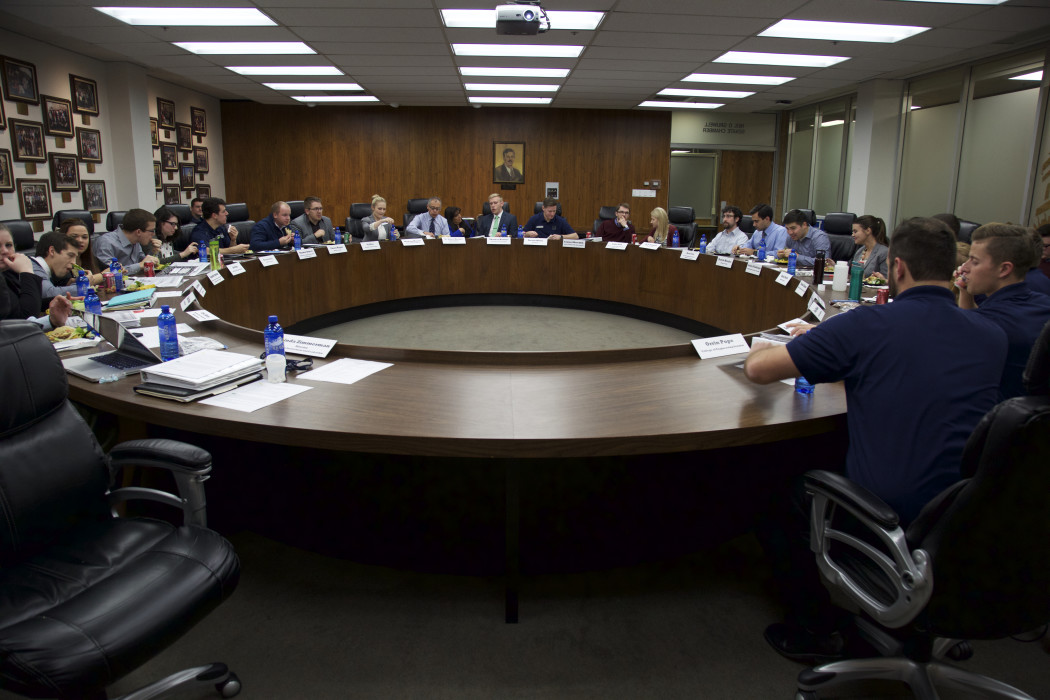USU Fee Board hears proposals for 2016-17 student fee increases
By Shanie Howard
The Student Fee Board at Utah State University held its first meeting Wednesday night for presentations on student fee increase proposals for the 2016-17 academic year.
Four organizations on campus requested to have additional students fees placed towards their programs in the coming school year, including Activities, Health and Wellness, Music and Theater, and Athletics.
Of the four organizations, Athletics asked for the largest increase.
After comparing the USU athletic budget to other colleges in the Mountain West Conference — the Aggies are dead last — and pointing out how beneficial athletic programs are to the USU student body, John Hartwell, vice president and director of athletics, proposed a student fee increase of $10 per student for the Athletics department.
The $10 increase would be added to the current athletics fee of $135.14, a 7.5 percent rise.
Hartwell said the current budget of the USU Athletics program is just shy of $29.3 million and the projected budget for next year is $32.6 million. Only 15 percent of the budget is currently made up of student fees.
He said the funds from this increase would be used to benefit students by adding two new video boards to the football stadium as well as a new sound system, and that a new video board would be added to both USU’s soccer and softball fields.
The true intent of how the Athletics Department is planning on spending the revenue from the increase was challenged by Casey Major, a student-at-large on the fee board.
“This last year you went about $500,000 in the hole … so by granting you this increase, are we really just bailing out the Athletics Department?” Major said.
The student fee for Activities is split between two places in the Student Involvement and Leadership Center (SILC): Student Involvement and Leadership and the Statesman. Activities is asking for an increase of $2.42 overall — $1.71 for the SILC fee and 71 cents for the Statesman fee.
Currently, the SILC fee is $31.85 and the Statesman fee is $4.10 for a full-time student with 12 to 18 credits.
Linda Zimmerman, director of SILC, and Kevin Webb, associate director of the center, presented the proposal.
They are asking for the money to increase the salary for four of the advisers within Student Involvement to exempt pay, due to new legislation that calls for non-exempt employees to work a strict 40 hours a week instead of having salary-based pay, with a “work until the job is done” expectation.
There are three solutions Zimmerman and Webb presented to manage the legislative change, which will be effective in the 2016-17 academic year. These solutions include the use of some of SILC’s reserve fund for one year, taking the fee proposal to Tier II tuition for students to pay in that way, or to increase the Activities fee to compensate for the salary increase of the four non-exempt advisers.
“We’re supporting option three … the biggest reason for that is it keeps all of our salary dollars coming from the student fee,” Webb said. “If we did a Tier II increase, it would just be different money coming from students so it just makes more sense for us to keep that the same and maintain all of our personnel budget coming from student fees.”
If the four advisers became exempt workers, it would be unnecessary for SILC to hire another adviser to work the extra hours current advisers work over 40. It would also help the advisers’ maintain their current level of involvement, which would benefit the students and programs.
The Health and Wellness department proposed an increase in student fees by an additional $2. This increase in funds for the department would go strictly to hiring a new psychiatrist.
Jim Davis, the executive director of the Health and Wellness Center, showed evidence that about 15,000 students use the center every year and the majority of them are diagnosed with physiological diseases rather than physical ones.
Although USU does have counseling and psychological services available, Davis said that being able to take a student directly to a psychologist when they did come into the center would be much more beneficial for the student, both in the diagnostic and overall mental health.
The Music and Theater department of the program presented the lowest proposal during the meeting, asking for only a $1 increase to student fees. The increase would be used to counteract the inflation that was predicted to be at 8.7 percent in the upcoming academic year.
In addition, the increased funding would also be used to add more theatrical effects to performances put on by the department. Members representing the department during the presentation said that by adding these effects, the number of students attending shows would increase.
However, when asked for proof of this claim, they came up empty handed. Nevertheless, the department did hold its position on the need for more effects.
“The very thing we want to do is what the students come to us and ask for,” said Chris Terry, associate dean over student affairs for the Caine College of the Arts.
Students who wish to see where their student fees are currently going can visit the online 2015-16 Tuition and Fees breakdown sheet here.


8.7% inflation?? That would be more than double the highest inflation rate that the US has seen in the past 10 years. The Music and Theater department couldn’t provide any support for increasing attendance at their performances; could they for their doomsday inflation scenario?
http://www.usinflationcalculator.com/inflation/current-inflation-rates/